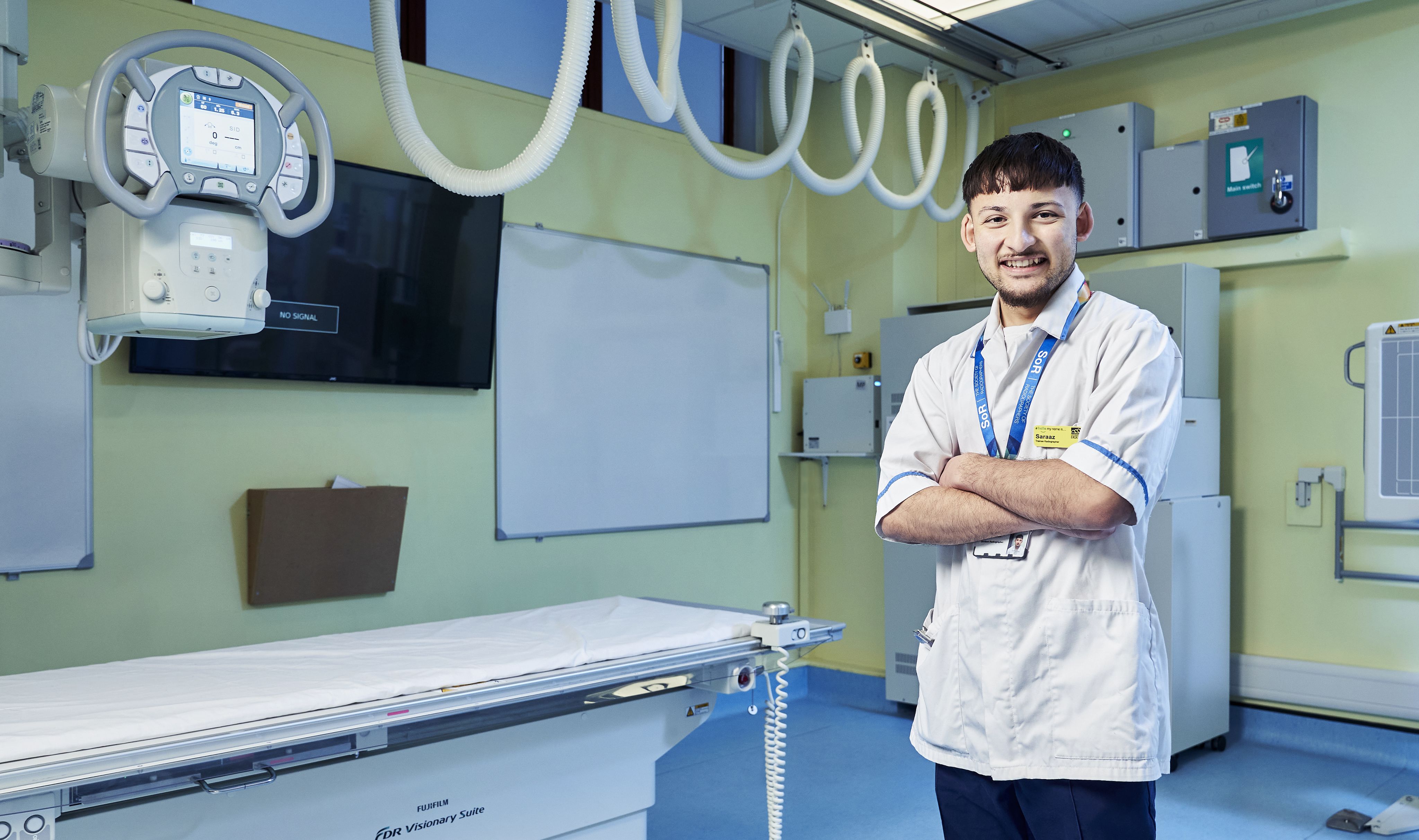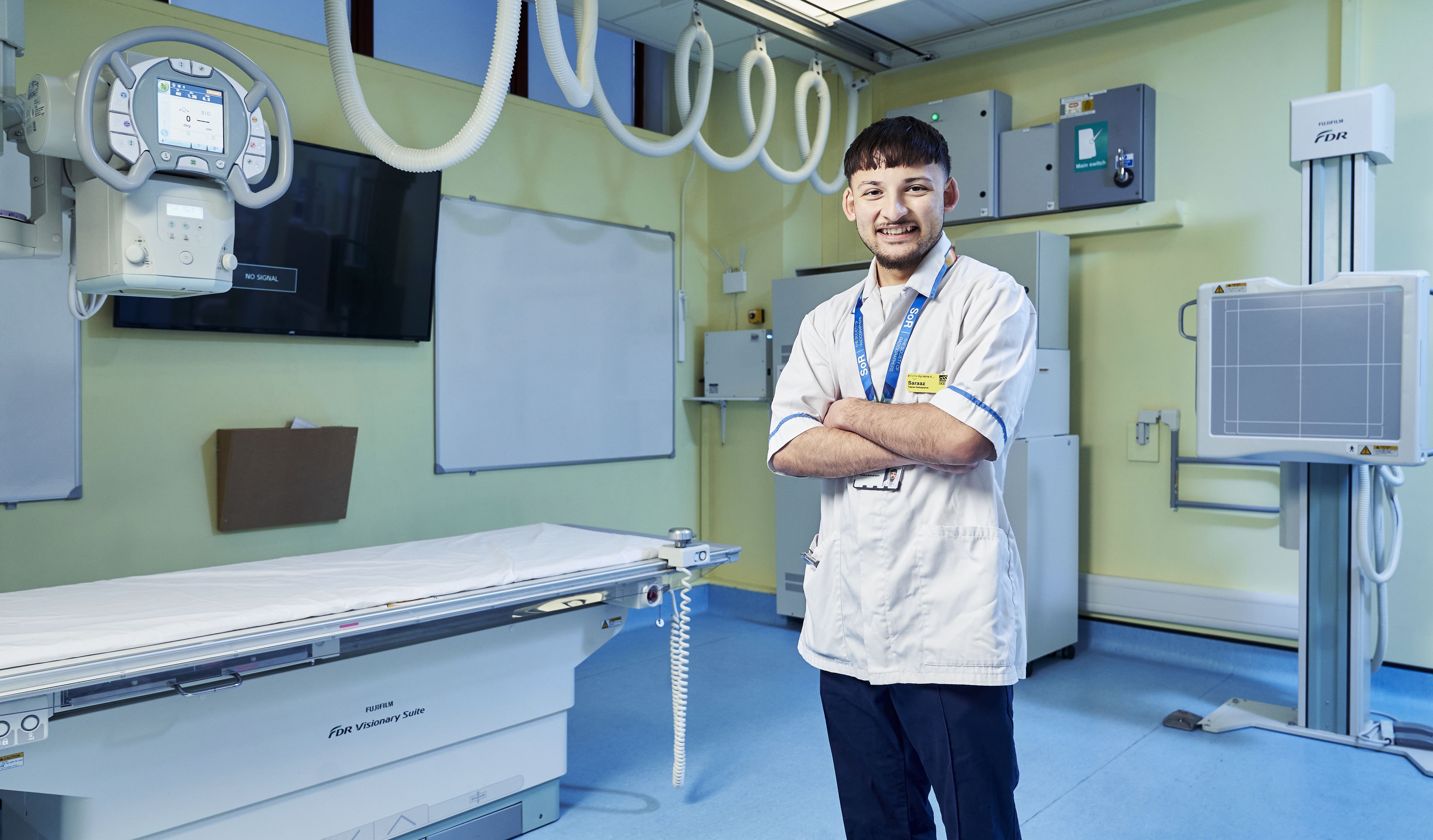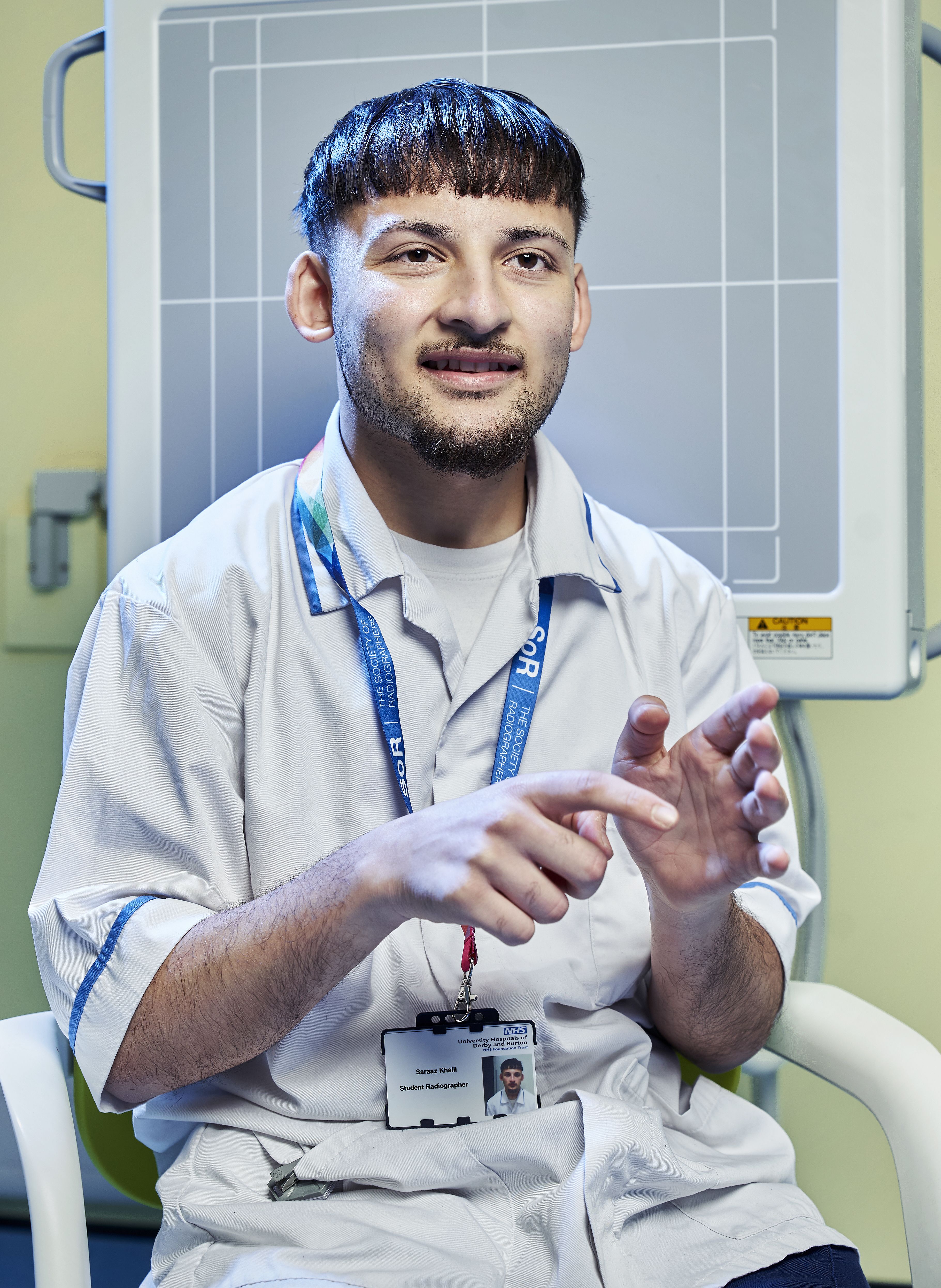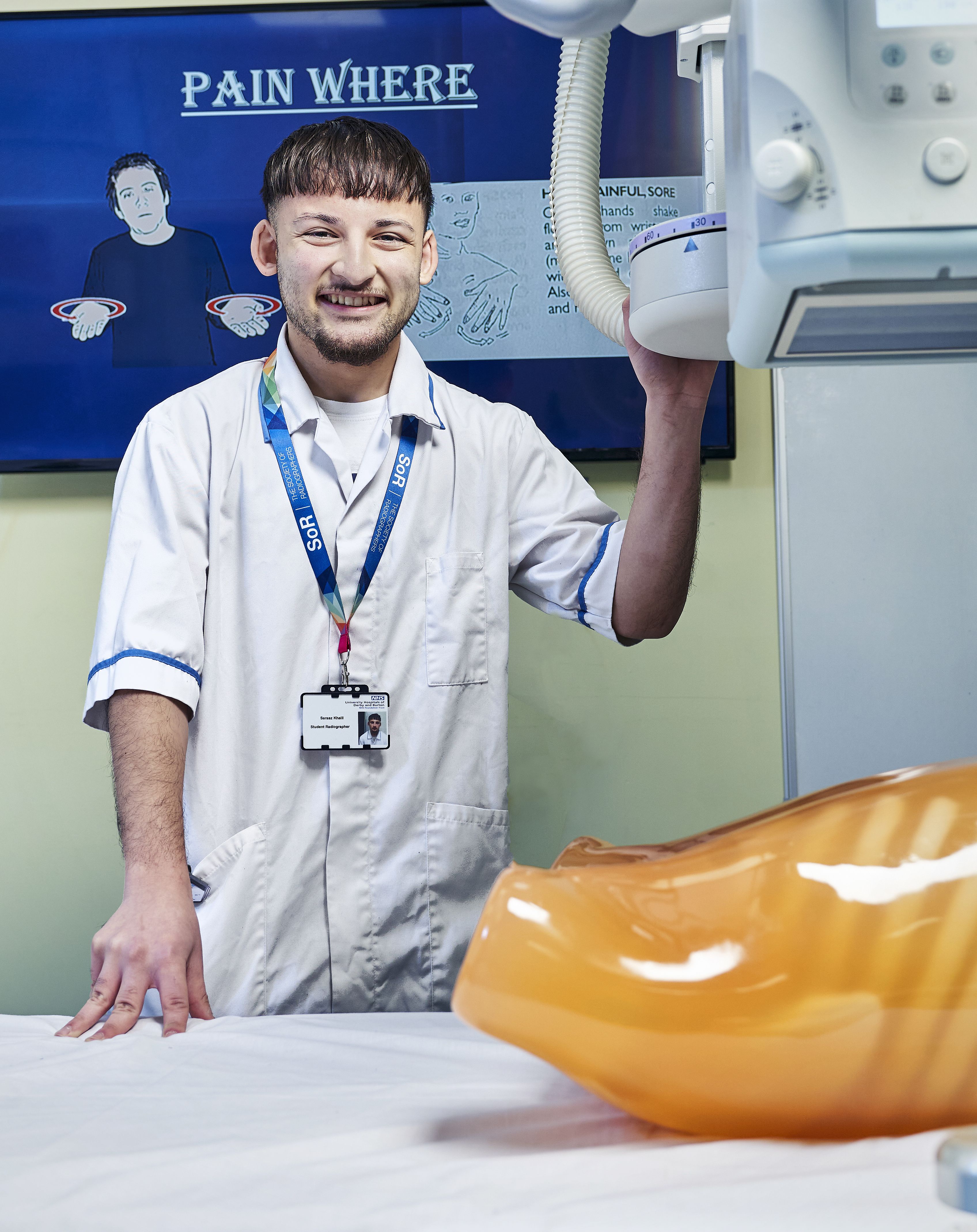Sign language: An essential skill for radiographers?
Student radiographer Saraaz Khalil is working to spread awareness of the struggles of deaf people in healthcare, and sat down with Synergy to talk about why radiographers should learn British Sign Language

Sign language: An essential skill for radiographers?
Student radiographer Saraaz Khalil is working to spread awareness of the struggles of deaf people in healthcare, and sat down with Synergy to talk about why radiographers should learn British Sign Language

Saraaz Khalil is an undergraduate final year student, studying radiography at the University of Derby. For the past few months, Saraaz has been trying to spread the word about the lack of support for deaf and hard of hearing patients within healthcare.
A lack of communication
Currently there are 87,000 deaf people who use British Sign Language (BSL) nationwide, according to the British Deaf Association, but only one interpreter for every 53 deaf people.
“It’s a massive shortage across healthcare ,” Saraaz explained. “You can’t be at 55 consultations, or appointments, or scans at once. I immediately realised that clearly this is a barrier to healthcare but also to medical imaging.
“I started speaking to people and learning more about BSL in radiography as a whole. What I came to realise was that not many can even say ‘Hello, my name is…’ in BSL, nor can they spell their name, nor can they even show the simple terms of what indicates X-ray. Just from a safety perspective, that’s really scary.
“A lot of [deaf] people decide that healthcare just isn't for them and they stay away. And that increases mortality rates, especially within the UK, with people getting older.”
Saraaz started speaking to people who do use BSL, and found that many were diagnosed with neurodivergency or hearing impairments late in life and only became aware of BSL after diagnosis – they didn’t even know BSL was something they could use, but once they did, it changed their lives.
“I want students and other qualified personnel to know that it's important to know about BSL, that not only will learning it improve their scope of practice, but it will also change other people's lives permanently. It's not great that we're not able to integrate these initiatives.”
However, Saraaz acknowledges that it will take a long and difficult road to integrate BSL into healthcare in any way. But he has started to make his own impacts in this area, by developing a guide for radiography undergraduate and postgraduate students, which will be developed into a prompt guidebook with tips and tricks for healthcare professionals, to be handed out at NHS trusts across the country.
“Once the word starts to spread, and a few trusts start considering making BSL a standard policy, it will become a domino effect,” he said. “Once people start to realise that it's cheaper to up-skill and train people in BSL internally than pay for interpreters, that will start to bridge the gap in shortage specialisms. Integrating that collectively is a win-win for everyone.”
While the initiative will start small, Saraaz told Synergy he hopes to spread the word and garner the attention of hospital bosses across the country.
Saraaz also highlighted how in the Health and Care Professions Council (HCPC), the UK regulator for many healthcare professions including radiographers, registration requires that students, among other things, “take all reasonable steps to make sure that you can communicate appropriately and effectively with service users and carers.”
He added, however: “There’s no detail on what that means. My focus is in spreading awareness so I can get in touch with the HCPC and they can amend the regulations to include BSL as one method to get that effective communication. Once that’s been implemented as a requirement to be registered, the NHS can apply policies where they up-skill and train, they can create e-learning programmes.”
Saraaz Khalil is an undergraduate final year student, studying radiography at the University of Derby. For the past few months, Saraaz has been trying to spread the word about the lack of support for deaf and hard of hearing patients within healthcare.
A lack of communication
Currently there are 87,000 deaf people who use British Sign Language (BSL) nationwide, according to the British Deaf Association, but only one interpreter for every 53 deaf people.
“It’s a massive shortage across healthcare ,” Saraaz explained. “You can’t be at 55 consultations, or appointments, or scans at once. I immediately realised that clearly this is a barrier to health care but also to medical imaging.
“I started speaking to people and learning more about BSL in radiography as a whole. What I came to realise was that not many can even say ‘Hello, my name is…’ in BSL, nor can they spell their name, nor can they even show the simple terms of what indicates X-ray. Just from a safety perspective, that’s really scary.
“A lot of [deaf] people decide that healthcare just isn't for them and they stay away. And that increases mortality rates, especially within the UK, with people getting older.”
Saraaz started speaking to people who do use BSL, and found that many were diagnosed with neurodivergency or hearing impairments diagnosed late in life and only became aware of BSl after diagnosis – they didn’t even know BSL was something they could use, but once they did, it changed their lives.
“I want students and other qualified personnel to know that it's important to know about BSL, that not only will learning it improve their scope of practice, but it will also change other people's lives permanently. It's not great that we're not able to integrate these initiatives.”
However, Saraaz acknowledges that it will take a long and difficult road to integrate BSL into healthcare in any way. But he has started to make his own impacts in this area, by developing a guide for radiography undergraduate and postgraduate students, which will be developed into a prompt guidebook with tips and tricks for healthcare professionals, to be handed out at NHS trusts across the country.
“Once the word starts to spread, and a few trusts start considering making BSL a standard policy, it will become a domino effect,” he said. “Once people start to realise that it's cheaper to up-skill and train people in BSL internally than pay for interpreters, that will start to bridge the gap in shortage specialisms. Integrating that collectively is a win-win for everyone.”
While the initiative will start small, Saraaz told Synergy he hopes to spread the word and garner the attention of hospital bosses across the country.
Saraaz also highlighted how in the Health and Care Professions Council (HCPC), the UK regulator for many healthcare professions including radiographers, registration requires that students, among other things, “take all reasonable steps to make sure that you can communicate appropriately and effectively with service users and carers.”
He added, however: “There’s no detail on what that means. My focus is in spreading awareness so I can get in touch with the HCPC and they can amend the regulations to include BSL as one method to get that effective communication. Once that’s been implemented as a requirement to be registered, the NHS can apply policies where they up-skill and train, they can create e-learning programmes.”
Inspiring activism
Saraaz is originally from Leeds, where his BSL initiative was born. He is also on the Society of Radiographers’ Advisory Board for Education.
Saraaz has appeared on the BBC, has presented at the United Kingdom Imaging and Oncology (UKIO) conference, and has also been involved with the European Federation of Radiographer Societies.
He told Synergy: “I’ve been a massive advocate of continuing professional development. I want to be an ambassador not just for students, but also for the existing workforce to develop and make changes that can integrate people into care a lot better.”
Saraaz explained that his brother has mild autism, and the two of them sometimes use BSL to communicate: “When you’re neurodivergent, you’re not always able to communicate in a large, busy audience, to speak to people socially – those interactive skills can sometimes struggle.”
He went on to explain that not only would greater implementation of BSL programmes help the radiography workforce to improve their communication skills, but it could also help protect from a legal perspective. Malpractice and the ability to confirm safety checks, the ability to check on informed consent, and considering mental capacity for patients will all help radiographers.
Campaigning for the deaf
The University of Derby is home to the UK’s only Royal School for the Deaf, founded in 1894. Outside of London, Derbyshire has the highest number of deaf people living and working in the county than anywhere else in the country, proportionate to population.
Saraaz described the Kate Granger campaign as being a massive influence and inspiration for his work.
Kate was a consultant doctor who was diagnosed with terminal cancer in 2011 and subsequently started the #HelloMyNameIs campaign, encouraging health workers to introduce themselves to patients. During her treatment, Kate realised a lot of the consultants liaising with her were unaware of her competence or profession. Her campaign had an enormous impact and two years after it launched more than 400,000 doctors, nurses, therapists, receptionists and porters had endorsed the initiative. Kate died in July 2016, aged 34.
“[Staff] wouldn’t even say ‘hello, my name is’ and what she said was this really affected her, because of her situation.” Saraaz said.
“They weren’t even able to communicate and support her by adapting to her. She felt really isolated and she didn’t want to go into healthcare to ask for support.
“So she introduced, during the last stages of her life, the #HelloMyNameIs campaign. She tried to encourage everyone to say those words within the hospital, regardless of whether they were a cleaner, a doctor, a radiographer, a consultant – any scope of practice. Now, the NHS has applied that nationwide.
“For me, her campaign made me realise she had an initiative, and she realised there was an impact to be made. She stuck by it, and eventually, even the NHS realised it was something to consider.
“I think that's the pathway that I'm considering for the BSL programme, because it's good and all having a conversation, or having something briefly spoken about, but this has to be applied on a day to day basis.”
Campaigning for the deaf
The University of Derby is home to the UK’s only Royal School for the Deaf, founded in 1894. Outside of London, Derbyshire has the highest number of deaf people living and working in the county than anywhere else in the country, proportionate to population.
Saraaz described the Kate Granger campaign as being a massive influence and inspiration for his work.
Kate Granger was a consultant doctor who was diagnosed with terminal cancer in 2011 and subsequently started the #HelloMyNameIs campaign, encouraging health workers to introduce themselves to patients. During her treatment, Kate realised a lot of the consultants liaising with her were unaware of her competence or profession. Her campaign had an enormous impact and two years after it launched, more than 400,000 doctors, nurses, therapists, receptionists and porters had endorsed the initiative. Kate died in July 2016, aged 34.
“[Staff] wouldn’t even say ‘hello, my name is’ and what she said was this really affected her, because of her situation.” Saraaz said.
“They weren’t even able to communicate and support her by adapting to her. She felt really isolated and she didn’t want to go into healthcare to ask for support.
“So she introduced, during the last stages of her life, the #HelloMyNameIs campaign. She tried to encourage everyone to say those words within the hospital, regardless of whether they were a cleaner, a doctor, a radiographer, a consultant – any scope of practice. Now, the NHS has applied that nationwide.
“For me, her campaign made me realise she had an initiative, and she realised there was an impact to be made. She stuck by it, and eventually, even the NHS realised it was something to consider.
“I think that's the pathway that I'm considering for the BSL programme, because it's good and all having a conversation, or having something briefly spoken about, but this has to be applied on a day to day basis.”
'MRI'
'X-ray'
A background in achievement
Saraaz comes from a family of surgeons, doctors, pharmacists, accountants and lawyers, he explained, but none of them were Allied Health Professionals.
However in secondary school Saraaz was given a chance to do work experience with a family member in the diabetes unit of the Quarry House in Leeds.
“There’s something within the NHS system that really grasped me, because I have always cared about people, but I didn’t really know what sector I’d want to work in,” he said.
At the end of his secondary school education, Saraaz went to St James University Teaching Hospital in Leeds on work experience, where he was first introduced to radiography.
He said: “I thought, wow, it’s a practical job, it makes a difference – without diagnosis, not many patients are going to be able to receive any form of pathway recovery treatment, because until you diagnose you can’t know what’s wrong with a patient. The scope was massive – and I realised if I put my heart and soul into my first year, I could potentially progress from a Band 5 radiographer to a Band 7 within a year of graduating.”
Saraaz is now attending the University of Derby because of its cutting edge simulation platforms and the status of the senior leads, who he described as “advocates on an international level.”
However, towards the end of his first year, Saraaz realised that he felt something was missing.
“I started to look at the scope of radiography to work out what was wrong,” he explained. “It was the CPD aspect, that ability to empower and encourage existing students, but also make a difference in the existing workforce. That’s why I decided to volunteer at UKIO.”
It was in volunteering at UKIO in 2023 that Saraaz first talked to other attendees about the communication aspect of HCPC requirements. Fujifilm, in attendance to promote its radiographic innovation, was attempting to integrate voice application to its systems, as part of efforts to bolster effective communication abilities.
This prompted Saraaz to start thinking about gaps in communication within radiography services.
However it wasn’t until experiences at the hospital in 2022 and 2023 that Saraaz realised the depths of the problem. In one case, a deaf patient was turned away by staff due to an inability to communicate.
“I went into hospital one day and there was this one patient there – they were confined in the corner, almost shaking, trembling, and this person was deaf. I got firsthand experience. It must have been destiny that I saw that, because it made me realise firsthand the impact it had, not only on the patient, but also on the member of staff.
“The staff didn’t have a clue what to do. They were running in circles, getting in touch with seniors. But no one could speak BSL, so what could they do? In the end, unfortunately, the patient got turned away. If that patient was part of a hip pathway, or a lung malignancy pathway, not having that X-ray could be the difference between them being terminally ill and not knowing they’re terminally ill. That made me feel horrible.”
Saraaz further added that this work had been a lot, on top of coursework, placements, and job-seeking, all of which had been ramped up in his third year – but he emphasised that when other students ask how he does it, he said simply: “I care.”
“I care and I want to make a difference in the world. In order to do that, sometimes you’ve got to break barriers you didn’t think you could break in a million years. That’s the ethos of the NHS,” he said.
“The advice I’d give is be confident, be resilient, because it’s not easy. I’d be lying if I said I’ve been planning these opportunities. It’s been a good year and a half in the making, I’ve had to fight and send countless emails, travel to places I never thought I’d go.
“Be caring. In order to do the things I’m doing, regardless of what it is, you have to dig deep within yourself and understand, why am I in this profession in the first place? What do I want from what I’m doing?
“As long as someone is confident, resilient, hardworking, and they understand what care and compassion is – not just for other people, but for themselves – I think they've got the assets and the capability to achieve. Regardless of what background you come from, or what languages you speak, regardless of your gender, regardless of everything that is out there, we're all equal. We're all trying to break barriers.”
Saraaz is now attending the University of Derby because of its cutting edge simulation platforms and the status of the senior leads, who he described as “advocates on an international level.”
However, towards the end of his first year, Saraaz realised that he felt something was missing.
“I started to look at the scope of radiography to work out what was wrong,” he explained. “It was the CPD aspect, that ability to empower and encourage existing students, but also make a difference in the existing workforce. That’s why I decided to volunteer at UKIO.”
It was in volunteering at UKIO in 2023 that Saraaz first talked to other attendees about the communication aspect of HCPC requirements. Fujifilm, in attendance to promote its radiographic innovation, was attempting to integrate voice application to its systems, as part of efforts to bolster effective communication abilities.
This prompted Saraaz to start thinking about gaps in communication within radiography services.
However it wasn’t until experiences at the hospital in 2022 and 2023 that Saraaz realised the depths of the problem. In one case, a deaf patient was turned away by staff due to an inability to communicate that Saraaz realised the depths of the problem.
He said: “I went into hospital one day and there was this one patient there – they were confined in the corner, almost shaking, trembling, and this person was deaf. I got firsthand experience. It must have been destiny that I saw that, because it made me realise firsthand the impact it had, not only on the patient, but also on the member of staff.
“The staff didn’t have a clue what to do. They were running in circles, getting in touch with seniors. But no one could speak BSL, so what could they do? In the end, unfortunately, the patient got turned away. If that patient was part of a hip pathway, or a lung malignancy pathway, not having that X-ray could be the difference between them being terminally ill and not knowing they’re terminally ill. That made me feel horrible.”
Saraaz further added that this work had been a lot, on top of coursework, placements, and job-seeking, all of which had been ramped up in his third year – but he emphasised that when other students ask how he does it, he said simply: “I care.”
“I care and I want to make a difference in the world. In order to do that, sometimes you’ve got to break barriers you didn’t think you could break in a million years. That’s the ethos of the NHS,” he said.
“The advice I’d give is be confident, be resilient, because it’s not easy. I’d be lying if I said I’ve been planning these opportunities. It’s been a good year and a half in the making, I’ve had to fight and send countless emails, travel to places I never thought I’d go.
“Be caring. In order to do the things I’m doing, regardless of what it is, you have to dig deep within yourself and understand, why am I in this profession in the first place? What do I want from what I’m doing?
“As long as someone is confident, resilient, hardworking, and they understand what care and compassion is – not just for other people, but for themselves – I think they've got the assets and the capability to achieve. Regardless of what background you come from, or what languages you speak, regardless of your gender, regardless of everything that is out there, we're all equal. We're all trying to break barriers.”
Find out more...
British Sign Language is a visual means of communication using gestures, facial expressions and body language, mainly used by people who are deaf.
BSL is the most common form of sign language in this country. It has its own grammatical structure and syntax, and is not dependent on or strongly related to spoken English.
According to the official BSL website, it is a common misconception that sign language is a global universal language, when in fact there can even be regional variation within Britain. Other countries have their own sign language.
Find out more about BSL here.
Image credit: Ian Davies
Now read ...




